Shots of Science – knuckle cracking & exercise
The mechanism behind knuckle cracking
After decades of debate (really) scientists may have finally agreed on what happens when you crack your knuckles. Is the sound made by a bubble forming in the joint liquid, or the bubble popping? Forming, popping, forming, popping – debate has raged. After subjecting a patient to extensive cine MRI, Kawchuck et al. have agreed with the original findings from 1947 that it is the formation of the gap between the joints that causes the sound. More specifically “cine MRI revealed rapid cavity inception associated with concurrent sound production and joint separation. Following these events, the resulting cavity was never seen to collapse; the cavity formed at the time of rapid joint separation then persisted past the point of sound production.” I dare you to read the whole paper and not squirm ever so slightly.
You are what your stomach says you are
There’s a lot of research coming out that shows that our guts have a lot more say over our bodies than we thought before. Serotonin – the happiness chemical – is a neurotransmitter, and as such you probably think it’s only related to the brain. But in fact around 90% of your serotonin is produced in the digestive tract. Elaine Hsiao and her team at Caltech have found that the microbes in your gut can affect how much serotonin is produced. Fellow, Author Jessica Yano says that their work “demonstrates that microbes normally present in the gut stimulate host intestinal cells to produce serotonin”, however Hsiao cautions against reading too much into the findings until further trials are conducted.
Any exercise is not better than no exercise
If you were hoping that the occasional stint on the stationary bicycle at the gym might help you stay fit, think again. A new study has found that acute exercise has no effect on liver fat in overweight men. The authors say that this “suggests that the long term effects of physical activity training cannot simply be explained by an additive effect of acute exercise bouts”. So I’m afraid it’s a 12 month gym membership or nothing.

Dangers of being a predator
A meta-study has showed that American eagles may make the mistake of hunting porcupines – often to their detriment. Todd Katzner and his colleagues looked through studies over a 100 year period and found that at least 9 large birds of prey had taken on porcupines and were left with spines in their faces and bodies. In more than a third of cases observed, the injuries proved fatal. The North American porcupine, a slow moving rodent, can definitely hold its own and is rarely preyed upon. After copping a face full of jewellery, this eagle can see why.
What a drop!

Maybe your Nan put aside a nice bottle of gin on the day that you were born to be opened on your 21st birthday. Ah, nothing as lovely as a nicely aged bottle of gin. Well, how about a 170-year old bottle of champagne? Scientists have analysed champagne bottles found in a shipwreck in the Baltic Sea to learn more about the wine making practices of the time. In an abstract that reads nearly like the label of a wine bottle, the researchers say that they were surprised by the high amount of iron and copper, either because the higher quality wine was mixed with some lower quality portions, or from the use of metallic vessels. The champagne is also lower in alcohol than modern champagne, leading me personally to conclude that this drop really wasn’t worth waiting for. Now where’s that gin?
Got a question? You can continue the science discussion all week on twitter @ThisHeadStuff
